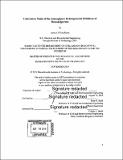Laboratory study of the atmospheric heterogeneous oxidation of benzo[a]pyrene
Author(s)
Rowe, James Clifford.
Download1144932431-MIT.pdf (5.226Mb)
Other Contributors
Massachusetts Institute of Technology. Department of Civil and Environmental Engineering.
Advisor
Jesse H. Kroll.
Terms of use
Metadata
Show full item recordAbstract
Polycyclic aromatic hydrocarbons (PAHs) are a class of chemical pollutants found ubiquitously in the environment. PAHs are carcinogenic and mutagenic, and the reaction of PAHs in the atmosphere can significantly alter their health effect. The heterogeneous reaction of particle-phase benzo[a]pyrene (BaP) with atmospheric oxidants ozone (O₃) and hydroxyl radical (OH) was investigated by simulating atmospheric conditions in a laboratory environmental chamber and measuring the particle-phase species with an Aerodyne Mass Spectrometer (AMS). Kinetic parameters of each reaction were calculated and lifetimes against reaction in the atmosphere are estimated to be of 2.58 and 3.38 hours for O₃ and OH, respectively. The main reaction products revealed by the AMS for both reaction systems were BaP-dione isomers (C₂, 4-a n benzo[d,ef]chrysene-5-one (C₁₉H₁₂O₂), and BaP epoxide or diol (C₂₀H₁₂O)). These products were also observed using liquid chromatography mass spectrometry (LCMS), validating the AMS as an effective, on-line method for product identification of PAH reaction products. Elemental analysis by the AMS revealed a higher oxygen to carbon ratio in the products of reaction with OH versus O₃, suggesting OH has higher reactivity with primary reaction products (PRPs) and forms secondary reaction products (SRPs) with higher oxygen content. The calculated kinetic parameters in this study may be of use for atmospheric modelling and the products identified in this study are targets for health studies of BaP reaction products. Additional studies are needed to determine the effect of particle properties on the heterogeneous reaction rate and the identity of SRPs.
Description
Thesis: S.M., Massachusetts Institute of Technology, Department of Civil and Environmental Engineering, 2019 Cataloged from PDF version of thesis. Includes bibliographical references (pages 51-55).
Date issued
2019Department
Massachusetts Institute of Technology. Department of Civil and Environmental EngineeringPublisher
Massachusetts Institute of Technology
Keywords
Civil and Environmental Engineering.